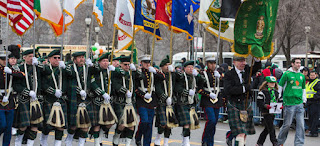ST. PATRICK’S DAY CELEBRATIONS IN CHICAGO
Every year on March 17, the Irish and the Irish-at-heart across the globe observe St. Patrick’s Day. What began as a religious feast day for the patron saint of Ireland has become an international festival celebrating Irish culture with parades, dancing, special foods and a whole lot of green.
There are 34.7 million U.S. residents with Irish ancestry. This number is more than seven times the population of Ireland itself.
THE CHICAGO RIVER ON ST. PATRICK’S DAY
As Irish immigrants spread out over the United States, other cities developed their own traditions. One of these is Chicago’s annual dyeing of the Chicago River green. The practice started in 1962, when city pollution-control workers used dyes to trace illegal sewage discharges and realized that the green dye might provide a unique way to celebrate the holiday. That year, they released 100 pounds of green vegetable dye into the river–enough to keep it green for a week! Today, in order to minimize environmental damage, only 40 pounds of dye are used, and the river turns green for only several hours.
St Patrick's Day Parade
The first St. Patrick’s Day parade took place in the United States on March 17, 1762, when Irish soldiers serving in the English military marched through New York City.
The Parade always occurs on a Saturday. If St. Patrick's Day does not fall on a Saturday, the Parade is held the Saturday before. The Parade always steps off at noon.
The Irish in Chicago have always exhibited a remarkable sense of community, solidarity and togetherness. It is that sense of community that has nurtured the prosperity of Irish-Americans here. The Chicago Irish-American Bar Association aims to embody the spirit of previous Irish generations by bringing together the Irish-American legal community and fostering its continued development.
Irish was estimated to be the top ancestry in Chicago in 2010, closely followed by German and Polish, which were ahead two decades ago. But the Irish-American population has dropped since 1990 by about 16.4 percent, or about 39,000 people, according to U.S. census data.
When the Irish diaspora began with the coming of the Great Famine in 1845, the City of Chicago was only 8 years old with a population of 6000. Thus, the early Irish immigrants in Chicago, in contrast to their counterparts in the great US cities of the east coast, had a genuine opportunity to be a part of, and contribute to, the growth of Chicago from its inception. It was an opportunity the Irish seized.
http://www.chicagostpatsparade.com/parade-and-river-dyeing.html
http://www.chicagotribune.com/
www.chicagostpatsparade.com
http://chicagoirishamericanbar.com/history















































